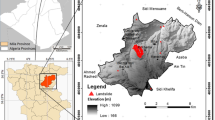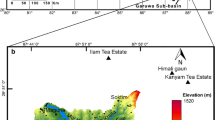Abstract
The susceptibility of landslides and the effect of landslide-related factors at Penang in Malaysia using the geographic information system (GIS) and remote sensing data have been evaluated. Landslide locations were identified in the study area from interpretation of aerial photographs and from field surveys. Topographical and geological data and satellite images were collected, processed, and constructed into a spatial database using GIS and image processing. The factors chosen that influence landslide occurrence were: topographic slope, topographic aspect, topographic curvature and distance from drainage, all from the topographic database; lithology and distance from lineament, taken from the geologic database; land use from Landsat Thermatic Mapper (TM) satellite images; and the vegetation index value from SPOT HRV (High-Resolution Visible) satellite images. Landslide hazardous areas were analyzed and mapped using the landslide-occurrence factors employing the probability–frequency ratio method using the all factors. To assess the effect of these factors, each factor was excluded from the analysis, and its effect verified using the landslide location data. As a result, all factors had relatively positive effects, except lithology, on the landslide susceptibility maps in the study area.



Similar content being viewed by others
References
Atkinson PM, Massari R (1998) Generalized linear modeling of susceptibility to landsliding in the central Apennines, Italy. Comput Geosci 24:373–385
Baeza C, Corominas J (2001) Assessment of shallow landslide susceptibility by means of multivariate statistical techniques. Earth Surf Process Landforms 26:251–1263
Carro M, De Amicis M, Luzi L, Marzorati S (2003) The application of predictive modeling techniques to landslides induced by earthquakes: the case study of the 26 September 1997 Umbria-Marche earthquake (Italy). Eng Geol 69:139–159
Clerici A, Perego S, Tellini C, Vescovi P (2002) A procedure for landslide susceptibility zonation by the conditional analysis method. Geomorphology 48:349–364
Dai FC, Lee CF (2002) Landslide characteristics and slope instability modeling using GIS, Lantau Island, Hong Kong. Geomorphology 42:213–228
Dai FC, Lee CF, Li J, Xu ZW (2001) Assessment of landslide susceptibility on the natural terrain of Lantau Island, Hong Kong. Environ Geol 40:381–391
Donati L, Turrini MC (2002) An objective method to rank the importance of the factors predisposing to landslides with the GIS methodology: application to an area of the Apennines (Valnerina; Perugia, Italy). Eng Geol 63:277–289
Ercanoglu M, Gokceoglu C (2002) Assessment of landslide susceptibility for a landslide-prone area (north of Yenice, NW Turkye) by fuzzy approach. Environ Geol 41:720–730
Gokceoglu C, Sonmez H, Ercanoglu M (2000) Discontinuity controlled probabilistic slope failure risk maps of the Altindag (settlement) region in Turkey. Eng Geol 55:277–296
Guzzetti F, Carrarra A, Cardinali M, Reichenbach P (1999) Landslide hazard evaluation: a review of current techniques and their application in a multi-scale study Central Italy. Geomorphology 31:181–216
Jibson WR, Edwin LH, John AM (2000) A method for producing digital probabilistic seismic landslide hazard maps. Eng Geol 58:271–289
Lee S, Choi U (2003) Development of GIS-based geological hazard information system and its application for landslide analysis in Korea. Geosci J 7:243–252
Lee S, Min K (2001) Statistical analysis of landslide susceptibility at Yongin, Korea. Environ Geol 40:1095–1113
Lee S, Chwae U, Min K (2002a) Landslide susceptibility mapping by correlation between topography and geological structure: the Janghung area, Korea. Geomorphology 46:49–162
Lee S, Choi J, Min K (2002b) Landslide susceptibility analysis and verification using the Bayesian probability model. Environ Geol 43:120–131
Lee S, Ryu JH, Min KD, Won JS (2003a) Landslide susceptibility analysis using GIS and artificial neural network. Earth Surf Process Landforms 27:1361–1376
Lee S, Ryu JH, Lee MJ, Won JS (2003b) Landslide susceptibility analysis using artificial neural network at Boun, Korea. Environ Geol 44:820–833
Lee S, Ryu JH, Won JS, Park HJ (2004) Determination and application of the weights for landslide susceptibility mapping using an artificial neural network. Eng Geol 71:289–302
Luzi L, Pergalani F, Terlien MTJ (2000) Slope vulnerability to earthquakes at subregional scale, using probabilistic techniques and geographic information systems. Eng Geol 58:313–336
Ohlmacher GC, Davis JC (2003) Using multiple logistic regression and GIS technology to predict landslide hazard in northeast Kansas, USA. Eng Geol 69:331–343
Parise M, Jibson WR (2000) A seismic landslide susceptibility rating of geologic units based on analysis of characteristics of landslides triggered by the 17 January, 1994 Northridge, California earthquake. Eng Geol 58:251–270
Pistocchi A, Luzi L, Napolitano P (2002) The use of predictive modeling techniques for optimal exploitation of spatial databases: a case study in landslide hazard mapping with expert system-like methods. Environ Geol 41:765–775
Rautelal P, Lakheraza RC (2000) Landslide risk analysis between Giri and Tons Rivers in Himachal Himalaya (India). Int J Appl Earth Observ Geoinf 2:153–160
Rece A, Capolongo D (2002) Probabilistic modeling of uncertainties in earthquake-induced landslide hazard assessment. Comput Geosci 28:735–749
Refice A, Capolongo D (2002) Probabilistic modeling of uncertainties in earthquake-induced landslide hazard assessment. Comput Geosci 28:735–749
Romeo R (2000) Seismically induced landslide displacements: a predictive model. Eng Geol 58:337–351
Rowbotham D, Dudycha DN (1998) GIS modeling of slope stability in Phewa Tal watershed, Nepal. Geomorphology 26:151–170
Shou KJ, Wang CF (2003) Analysis of the Chiufengershan landslide triggered by the 1999 Chi-Chi earthquake in Taiwan. Eng Geol 68:237–250
Temesgen B, Mohammed MU, Korme T (2001) Natural hazard assessment using GIS and remote sensing methods, with particular reference to the landslides in the Wondogenet Area, Ethiopia. Phys Chem Earth (C) 26:665–615
Zhou CH, Lee CF, Li J, Xu ZW (2002) On the spatial relationship between landslides and causative factors on Lantau Island, Hong Kong. Geomorphology 43:197–207
Zhou G, Esaki T, Mitani Y, Xie M, Mori J (2003) Spatial probabilistic modeling of slope failure using an integrated GIS Monte Carlo simulation approach. Eng Geol 68:373–386
Author information
Authors and Affiliations
Corresponding author
Rights and permissions
About this article
Cite this article
Lee, S., Talib, J.A. Probabilistic landslide susceptibility and factor effect analysis. Environ Geol 47, 982–990 (2005). https://doi.org/10.1007/s00254-005-1228-z
Received:
Accepted:
Published:
Issue Date:
DOI: https://doi.org/10.1007/s00254-005-1228-z




